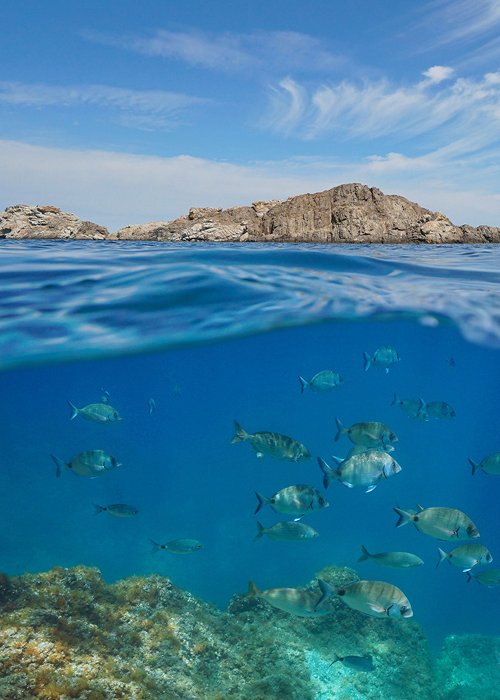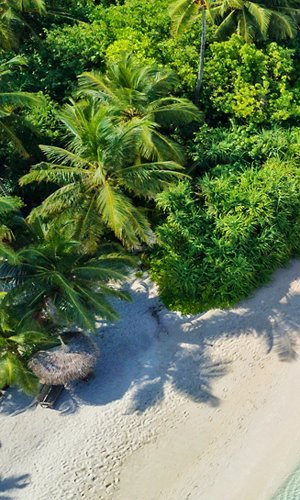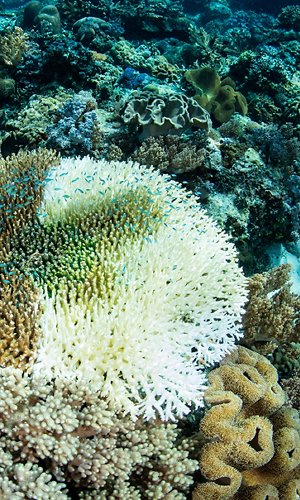Mare Nostrum
The Mediterranean Sea has always been considered of utmost importance for the economy and for cultural exchange between various peoples, uniting Italy with the Middle East and Africa. The Mediterranean area is considered to be the cradle of European civilisations; in fact, many of the major ancient cultures such as those of Egypt, Greece, Phoenicia and Rome developed there. Even today, around one third of international freight traffic passes through this region. Fishing, aquaculture and many commercial activities are an important source of Mediterranean-related wealth. Tourism is also an important source of earnings for this area, due to its special natural and cultural value.
The Mediterranean Sea is a semi-enclosed basin with an average depth of 1,500 m and a maximum depth of 5,267 m. The Mediterranean Sea represents only 0.7% of the surface area of all oceans, but it is estimated to host between 10,000 and 12,000 animal and plant species, or almost 10% of the total number of species inhabiting the seas of the entire planet.
Underwater Aliens
Recently there have been great changes in the fauna and flora of the Mediterranean due to climate change combined with the degradation of ecosystems, which are becoming increasingly vulnerable. Over the last few decades, reports of exotic species in the Mediterranean Sea have increased and people have begun to talk about its tropicalisation, a term that is being given wide coverage in the media, sometimes accompanied by unjustified alarmism. Tropicalisation refers to the process whereby species from tropical or sub-tropical areas that were previously foreign to the Mediterranean settle there. Tropical species that have entered the Mediterranean come mainly from the eastern Atlantic, through the Strait of Gibraltar, and from the Nile Basin and the Red Sea, through the Suez Canal. The latter is referred to as Lessepsian migration after the French engineer Ferdinand-Marie de Lesseps who designed the canal. There are also many species introduced voluntarily or accidentally mainly through bilge water (the bilge is the lowest part of a boat's hull that collects various drains and water seepage) and ballast water from ships, which are discharged into the sea without precaution.
A dam changed our sea
In 1869, the Suez Canal was opened. In the first years following the opening of the canal, species immigration was moderate. There may be different explanations for this phenomenon; one of them could be the high salinity of the Suez Canal bitter lakes that prevented marine species from reaching the Mediterranean, a salinity that decreased as a result of water moved by shipping. Another explanation could be the creation of a kind of barrier formed by the fresh water transported by the Nile, whose mouth is close to the mouth of the Suez Canal. After the construction of the Aswan Dam, which reduced the flow of the Nile and consequently the supply of fresh water, the natural barrier is thought to have broken down, allowing alien species to colonise our sea.
Aliens among us
Numerous species have arrived in the Mediterranean from the Suez Canal, adapting to the new conditions and beginning to reproduce.
The rapid adaptation of these species is due mainly to two reasons: the first is that there are around 1,500 species in the Red Sea with much higher competition between them than the 600 species in the Mediterranean; the second is the environmental vacuum that has been left by intensive fishing of Mediterranean fish, heavy metal and pesticide pollution, rising temperatures, and the reduction of the posidonia oceanica meadows, all phenomena that create imbalances in marine flora and fauna. About thirty species, on the other hand, arrive from the coasts of West Africa and the Atlantic, often attracted by the remains of food thrown from ships.
Some of the alien fish species that have been found in the Mediterranean are listed below.
Plotosus lineatus: called striped eel catfish, it has colonised the Middle Eastern coasts. The spines of the pectoral and first dorsal fins are poisonous.
Fistularia commersonii: commonly called the blue-spotted cornetfish, its elongated, threadlike body makes it very similar to the longspine snipefish.
Sargocentron rubrum: commonly known as the redcoat, widespread in the south-eastern Mediterranean Sea between eastern Libya and southern Turkey. It is not reported in Italian waters.
Leiognathus klunzingeri: also called slipmouth or pony fish, it is widespread in the south-eastern basin where locally it has formed dense populations; in Italian waters the species can be found in the waters around Sicily.
Upeneus moluccensis and Upeneus pori, two species of mullet that have spread so fast that they have displaced native mullets.
Lessepsian species colonised the eastern part of the Mediterranean very quickly due to the scarcity of fauna in this area, caused by biogeographical changes that left many ecological niches vacant. Only a small proportion of species have spread to the western part of our sea, because it has a much higher population of Atlantic-Mediterranean species.
Giant clams and killer algae
Among the tropical species that have started to populate our seas, there are also voluntarily introduced invertebrates such as the giant clam from the Philippines (Ruditapes philippinarum), native to the Pacific Ocean. It was introduced for commercial purposes in 1983 in the Venice Lagoon where, due to high trophic levels, a particular sediment and the movement of water due to tides, it found a perfect habitat and reproduced naturally, giving rise to extensive populations.
Even among plants we find cases of tropicalisation, such as the algae Caulerpa taxifolia, called 'killer algae' in a somewhat sensationalistic manner, because it infests and endangers posidonia oceanica meadows, the Mediterranean's green reserve. It is assumed that this algae was unintentionally introduced into the Mediterranean Sea by escaping from the tanks of the Oceanographic Museum in Monaco in 1984. The speed of propagation of this seaweed is incredible and within a decade it has spread from the coasts of Monte Carlo throughout Italy.
Ever closer neighbours
The term 'tropicalisation' of the Mediterranean is not to be confused with 'southernisation'. The latter refers to the tendency of certain organisms living in the warmer waters of the southern shores of the Mediterranean to extend their range to more temperate zones where they were previously absent. The phenomenon of southernisation has often been attributed to global warming, and indeed the last twenty years have seen an increase in warm water organisms in the northernmost parts of the Italian seas. Scientists, however, are still investigating whether there is a connection, as many other warm-water-loving species, similar in environmental requirements to the species that have expanded their range, have not shown the same tendency.
An example of a species that has moved northwards in recent years is the Thalassoma pavo, an example that is before the eyes of anyone who swims wearing a mask and fins in Italian seas. This, in fact, is a well-known fish commonly known as the ornate wrasse, one of the most commonly encountered fish at a depth of a few metres and one of the most colourful in our sea. Until about fifteen years ago it was only widespread in the waters of the far south of Italy and common only on Lampedusa and the other Pelagie Islands, today it can be frequently found as far north as the entire Ligurian Sea (but not in the northern Adriatic).
Another example is that of the Mediterranean parrotfish Sparisoma cretense, the only parrotfish found in this sea, rather conspicuous due to its bright red colouring with green spots and teeth welded together in a sort of beak. Until a few years ago, it was found only in Sicilian-Calabrian waters and is now quite common in the Tuscan Archipelago.







